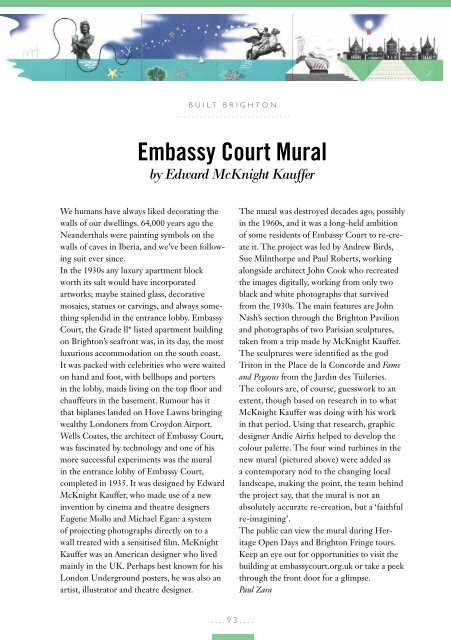Viva Brighton Issue #80 October 2019
- No tags were found...
You also want an ePaper? Increase the reach of your titles
YUMPU automatically turns print PDFs into web optimized ePapers that Google loves.
BUILT BRIGHTON<br />
.............................<br />
Embassy Court Mural<br />
by Edward McKnight Kauffer<br />
We humans have always liked decorating the<br />
walls of our dwellings. 64,000 years ago the<br />
Neanderthals were painting symbols on the<br />
walls of caves in Iberia, and we’ve been following<br />
suit ever since.<br />
In the 1930s any luxury apartment block<br />
worth its salt would have incorporated<br />
artworks; maybe stained glass, decorative<br />
mosaics, statues or carvings, and always something<br />
splendid in the entrance lobby. Embassy<br />
Court, the Grade ll* listed apartment building<br />
on <strong>Brighton</strong>’s seafront was, in its day, the most<br />
luxurious accommodation on the south coast.<br />
It was packed with celebrities who were waited<br />
on hand and foot, with bellhops and porters<br />
in the lobby, maids living on the top floor and<br />
chauffeurs in the basement. Rumour has it<br />
that biplanes landed on Hove Lawns bringing<br />
wealthy Londoners from Croydon Airport.<br />
Wells Coates, the architect of Embassy Court,<br />
was fascinated by technology and one of his<br />
more successful experiments was the mural<br />
in the entrance lobby of Embassy Court,<br />
completed in 1935. It was designed by Edward<br />
McKnight Kauffer, who made use of a new<br />
invention by cinema and theatre designers<br />
Eugene Mollo and Michael Egan: a system<br />
of projecting photographs directly on to a<br />
wall treated with a sensitised film. McKnight<br />
Kauffer was an American designer who lived<br />
mainly in the UK. Perhaps best known for his<br />
London Underground posters, he was also an<br />
artist, illustrator and theatre designer.<br />
The mural was destroyed decades ago, possibly<br />
in the 1960s, and it was a long-held ambition<br />
of some residents of Embassy Court to re-create<br />
it. The project was led by Andrew Birds,<br />
Sue Milnthorpe and Paul Roberts, working<br />
alongside architect John Cook who recreated<br />
the images digitally, working from only two<br />
black and white photographs that survived<br />
from the 1930s. The main features are John<br />
Nash’s section through the <strong>Brighton</strong> Pavilion<br />
and photographs of two Parisian sculptures,<br />
taken from a trip made by McKnight Kauffer.<br />
The sculptures were identified as the god<br />
Triton in the Place de la Concorde and Fame<br />
and Pegasus from the Jardin des Tuileries.<br />
The colours are, of course, guesswork to an<br />
extent, though based on research in to what<br />
McKnight Kauffer was doing with his work<br />
in that period. Using that research, graphic<br />
designer Andie Airfix helped to develop the<br />
colour palette. The four wind turbines in the<br />
new mural (pictured above) were added as<br />
a contemporary nod to the changing local<br />
landscape, making the point, the team behind<br />
the project say, that the mural is not an<br />
absolutely accurate re-creation, but a ‘faithful<br />
re-imagining’.<br />
The public can view the mural during Heritage<br />
Open Days and <strong>Brighton</strong> Fringe tours.<br />
Keep an eye out for opportunities to visit the<br />
building at embassycourt.org.uk or take a peek<br />
through the front door for a glimpse.<br />
Paul Zara<br />
....93....

















